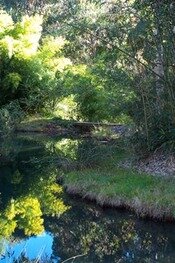Blog
Weeds and People
Weeds and people
One of the Festival garden exhibitors for Autumn said to me the other day, “Wow, the sour sob has suddenly appeared and growing fast, hasn’t it?”
Sour Sob

A type of oxalis, it is a classic survivor and hard to eradicate.
I realized looking around my garden a little later that my gardening friend was spot on. A couple of weeks before, no sign of these nuisance plants and then with a bit of rain, shorter days, up they came. In just a few days they were beginning to cover an area, crowding and shading other more genteel and diminutive plants that I would rather have. Sour sob, by the way, is an Oxalis (also known as the Wood Sorrel family) Oxalis pas-caprae, with a nutty bulb or tuber that lies dormant several centimetres below the surface over summer. The Guinea Fowl appear to have discovered them in that they dig down with great gusto to where the bulbs are. The plants are edible in small quantities, though they do contain oxalic acid and can cause oxalate poisoning in sheep.
Sour sob has bright shiny flowers of the purest yellow on cylindrical stalks, with leaflets that resemble clover. It is not just any old weed; it is a Declared Plant which means the landowner is required to control it though it is almost impossible to eradicate with no easy quick fix.
“What’s in a name? that which we call a rose By any other name would smell as sweet.” From Shakespeare’s “Romeo and Juliet”.
What is a weed? To paraphrase the above, “What’s in a name? that which we call a weed By any other name would be as noxious.”
The naming of a plant as a weed is essentially a human invention or construct. A weed is a plant growing where it is not wanted (by us). The plant is neutral in the matter. The plant in its original habitat may have been quite innocuous causing no particular harm or nuisance in its local environment. Then for various reasons it was transported either accidentally or deliberately to a new location, where it found conditions to its liking and thrived. It then began to compete with the local, indigenous plants often outcompeting them and taking over areas, or it began to grown in pasture where it was poisonous to stock. Other plants became weeds of crops or threatened orchards with their abundance.
We now have weeds of wetlands – think of the Arum lily – on sale in florist’s shops, but invasive of many wetland areas near the coast. In the inland South West this lily does not seem to be such a problem, perhaps our hotter summers and colder winters are not so much to its liking.
There are some fascinating contradictions in the weed story. These days with scarcer water supplies and the need to garden in a waterwise way we often look for plants that will tolerate dry conditions over summer and that can survive with minimal summer watering or none at all. Being mindful of fire risk is also essential to making sound choices for garden plants; thus choosing plants of low inflammability is important.
We can seek out plants from the local area or from similar climates; plants that come from South Africa or southern California or from around the Mediterranean. The dog rose (Rosa canina), species gladiolus, Californian poppies, arctotis and ixias are all good examples of plants that are perfectly adapted to our inland South West climate and will work well in gardens. However, these plants are so well adapted that they can become invasive weeds of nearby bushland – they can become garden escapes.
As I was buying bulbs of some of these well-adapted plants the other day, I asked about the potential for the Lachenalias and ixias, that I had bought, to escape from a garden. The reply was that these bulbous plants would stay in a garden if people did not transport them (read dump) beyond the garden. For some plants which spread their seeds by birds carrying them, such as the dog rose, or by wind it is probably simpler not to plant them or to consciously manage them very carefully so they do not spread beyond the garden.
Blackberry was introduced for its delicious, summer fruit, easy to grow!
We need to be careful about what we plant and where we put our garden refuse. The issue of weeds in our area is as much about people as it is about plants.



